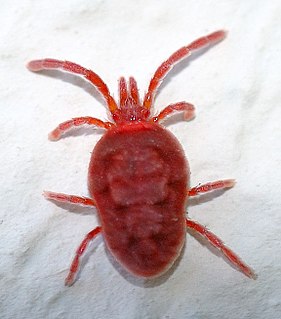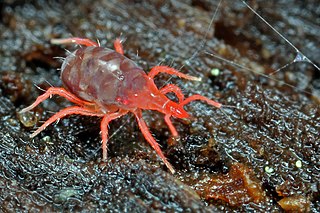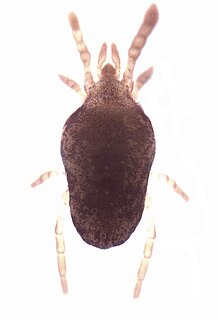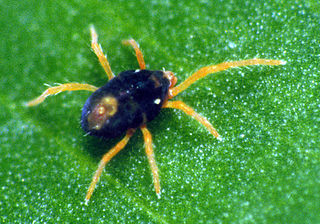
Mites are small arachnids.

The Acari are a taxon of arachnids that contains mites and ticks. The diversity of the Acari is extraordinary and their fossil history goes back to at least the early Devonian period. Acarologists have proposed a complex set of taxonomic ranks to classify mites. In most modern treatments, the Acari are considered a subclass of the Arachnida and are composed of two or three superorders or orders: Acariformes, Parasitiformes, and Opilioacariformes; the latter is often considered a subgroup within the Parasitiformes. The monophyly of the Acari is open to debate, and the relationships of the acarines to other arachnids is not at all clear. In older treatments, the subgroups of the Acarina were placed at order rank, but as their own subdivisions have become better understood, treating them at the superorder rank is more usual.

Psoroptidia is a parvorder of the Acari (mite) group Astigma. It comprises around 40 families, and apparently originated as parasites of birds, before a secondary radiation saw some taxa become parasites of mammals. Because of their parasitic lifestyle, members of the Psoroptidia do not exhibit a deutonymph stage.

The Proctophyllodidae are a family of the Acarina (mite) order Astigmata. They contain many feather mites. The Alloptidae and Trouessartiidae were in earlier times included here as subfamilies.
Limnochares americana is a species of mite in the family Limnocharidae.
Plateremaeidae is a family of oribatids in the order Sarcoptiformes. There are about 7 genera and 19 described species in Plateremaeidae.

Nanorchestidae is a family of endeostigs in the order Endeostigmata. There are at least two genera and two described species in Nanorchestidae.
Echimyopodidae is a family of arachnids in the order Astigmata. There are at least two genera and two described species in Echimyopodidae.

Chaetodactylidae is a family of mites in the order Sarcoptiformes. There are five genera: Sennertia, Chaetodactylus, Achaetodactylus, Centriacarus, and Roubikia.

Winterschmidtiidae is a family of mites in the order Astigmata. There are about six genera in Winterschmidtiidae.
Halacaridae is a family of meiobenthic mites found in marine, brackish, and freshwater habitats around the world. It includes more than 1100 described species belonging to 64 genera

Bdellidae is a family of snout mites in the order Trombidiformes. There are about 11 genera and at least 260 described species in Bdellidae.

Microtrombidiidae is a family of micro velvet mites in the order Trombidiformes. There are about five genera and seven described species in Microtrombidiidae.
Limnochares is a genus of mites in the family Limnocharidae. There are at least two described species in Limnochares.

Glycyphagus is a genus of astigs in the family Glycyphagidae. There are about five described species in Glycyphagus.

Linopodes is a genus of mites in the family Cocceupodidae. There are at least two described species in Linopodes.

Neotrombidium is a genus of velvet mites and chiggers in the family Neotrombidiidae. There are at least three described species in Neotrombidium.

Neotrombidiidae is a family of velvet mites and chiggers in the order Trombidiformes. There are at least four genera in Neotrombidiidae.

Panonychus is a genus of spider mites in the family Tetranychidae. There are about 16 described species in Panonychus.

Penthaleus major, known generally as the winter grain mite or blue oat mite, is a species of earth mite in the family Penthaleidae.














